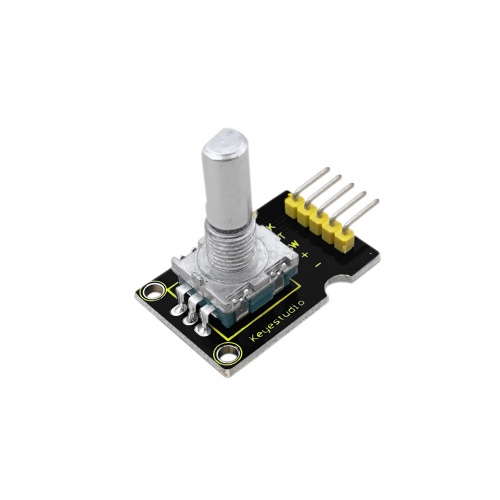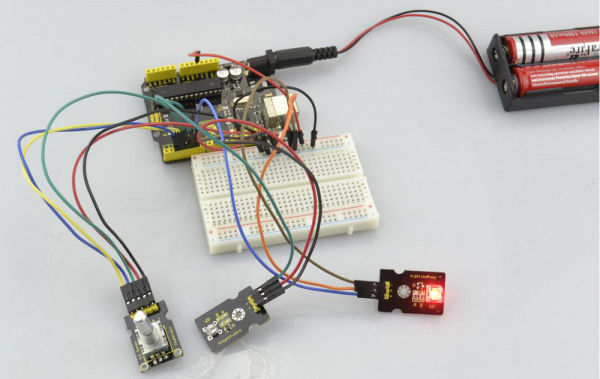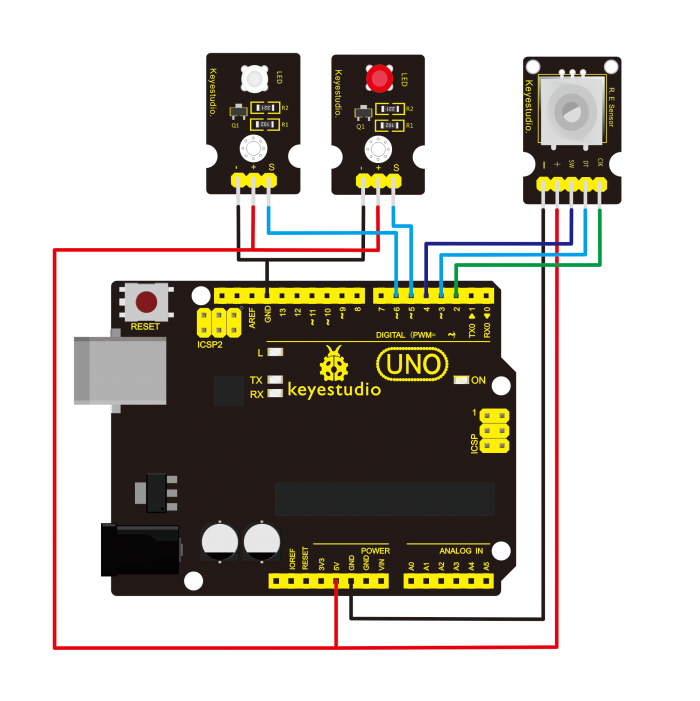Ks0013 keyestudio Rotary Encoder Module
Revision as of 13:18, 12 April 2019 by Keyestudio (talk | contribs)
Introduction
The rotary encoder can count the pulse outputting times during the process of rotation in positive and reverse direction by rotating. This rotating counting is unlimited, not like potential counting. It can be restored to initial state to count from 0.

Specification
- Power Supply: 5V
- Interface: Digital
Connection Diagram
Sample Code
const int interruptA = 0;
const int interruptB = 1;
int CLK = 2; // PIN2
int DAT = 3; // PIN3
int BUTTON = 4; // PIN4
int LED1 = 5; // PIN5
int LED2 = 6; // PIN6
int COUNT = 0;
void setup()
{
attachInterrupt(interruptA, RoteStateChanged, FALLING);
// attachInterrupt(interruptB, buttonState, FALLING);
pinMode(CLK, INPUT);
digitalWrite(2, HIGH); // Pull High Restance
pinMode(DAT, INPUT);
digitalWrite(3, HIGH); // Pull High Restance
pinMode(BUTTON, INPUT);
digitalWrite(4, HIGH); // Pull High Restance
pinMode(LED1, OUTPUT);
pinMode(LED2, OUTPUT);
Serial.begin(9600);
}
void loop()
{
if (!(digitalRead(BUTTON)))
{
COUNT = 0;
Serial.println("STOP COUNT = 0");
digitalWrite(LED1, LOW);
digitalWrite(LED2, LOW);
delay (2000);
}
Serial.println(COUNT);
}
//-------------------------------------------
void RoteStateChanged() //When CLK FALLING READ DAT
{
if (digitalRead(DAT)) // When DAT = HIGH IS FORWARD
{
COUNT++;
digitalWrite(LED1, HIGH);
digitalWrite(LED2, LOW);
delay(20);
}
else // When DAT = LOW IS BackRote
{
COUNT--;
digitalWrite(LED2, HIGH);
digitalWrite(LED1, LOW);
delay(20);
}
}
Result
Wiring well and uploading the above code, you can rotate the encoder module to randomly control two LED modules on and off.
When you rotate the encoder module, one LED module is turned on first but another one is off. If you continue to rotate the encoder module, one LED module becomes off while another one is turned on, repeatedly.

Resources
Video
http://video.keyestudio.com/ks0013/
PDF and Code:
https://drive.google.com/open?id=1Haca67UfKEHv0ssZ5b8TKQKGxyi9z0e9
